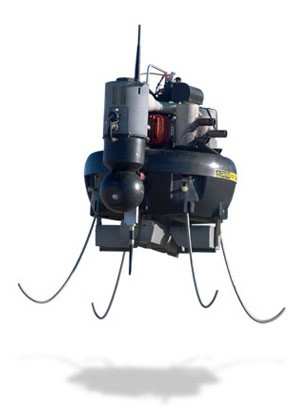Fri, Apr 22, 2011
Honeywell T-Hawk Provides Video Feed To Remote Monitors
Crews working to contain radiation and diagnose problems at
Japan’s Fukushima Daiichi nuclear facility get up-close video
and photos inside the plant as they work from a source rarely seen
outside military circles. Three employees of Honeywell have flown
five successful missions with the company's T-Hawk Micro Air
Vehicle (MAV), capturing hours of video and dozens of photos of the
nuclear reactor. The four T-Hawks in service at Fukushima Daiichi
have been adapted to carry radiation sensors.

“On behalf of all of us at Honeywell, our hearts go out to
the people of Japan, particularly those who have suffered as a
result of the earthquake and tsunami that damaged the Fukushima
Daiichi nuclear plant and surrounding areas,” said Tim
Mahoney, president and chief executive officer of Honeywell
Aerospace. “At Honeywell, we are proud of our commitment to
safety and security, and we are grateful that our technologies can
be deployed now to help the people of Japan in this historic time
of need.”
Currently deployed in war zones in Iraq and Afghanistan, the
T-Hawk features unique hover-and-stare capability that enables
pilots to hold it in one place and zoom in on features inside the
damaged reactors while the T-Hawk sends live video and still images
back to recovery workers. The T-Hawk also is capable of sending
live in-flight video feeds to help workers focus on critical areas
and adjust direction mid-flight. Pilots can control T-Hawk cameras
to alter angles and get better views of damaged equipment. Just 14
inches in diameter, the T-Hawk can be flown into tight spaces where
humans and other aircraft cannot go.
“The T-Hawk reminds us that innovative technologies
initially created for defense purposes can find crucial roles in
humanitarian and disaster recovery efforts,” Mahoney
said.

Weighing just 17 pounds, the T-Hawk is a ducted-fan vertical
takeoff and landing air vehicle originally designed in conjunction
with a Defense Advanced Research Projects Agency (DARPA) Advanced
Concept Technology Demonstration (ACTD) program. Pilots can
determine manual or autonomous flight paths from up to six miles
away for up to 40 minutes at a time.
The T-Hawk is a proven force multiplier in Afghanistan and Iraq,
where systems have been averaging more than six hours of flight
time a day. The T-Hawk is used in Afghanistan for route clearance,
infantry assault, and explosive ordnance disposal missions, where,
together with its similar work in Iraq, it has cumulatively flown
more than 17,000 hours. The United Kingdom’s Ministry of
Defence also deploys the T-Hawk for combat missions in Afghanistan
and trains with the T-Hawk in Afghanistan and Jordan. The T-Hawk is
currently being tested for urban use by the Miami-Dade Police
Department.
More News
Aero Linx: JAARS Nearly 1.5 billion people, using more than 5,500 languages, do not have a full Bible in their first language. Many of these people live in the most remote parts of>[...]
'Airplane Bounced Twice On The Grass Runway, Resulting In The Nose Wheel Separating From The Airplane...' Analysis: The pilot reported, “upon touchdown, the plane jumped back>[...]
"Burt is best known to the public for his historic designs of SpaceShipOne, Voyager, and GlobalFlyer, but for EAA members and aviation aficionados, his unique concepts began more t>[...]
"Polaris Dawn, the first of the program’s three human spaceflight missions, is targeted to launch to orbit no earlier than summer 2024. During the five-day mission, the crew >[...]
There Are SO Many Ways To Get YOUR Aero-News! It’s been a while since we have reminded everyone about all the ways we offer your daily dose of aviation news on-the-go...so he>[...]
 ANN's Daily Aero-Linx (05.04.24)
ANN's Daily Aero-Linx (05.04.24) NTSB Final Report: Quest Aircraft Co Inc Kodiak 100
NTSB Final Report: Quest Aircraft Co Inc Kodiak 100 Aero-News: Quote of the Day (05.04.24)
Aero-News: Quote of the Day (05.04.24) Aero-News: Quote of the Day (05.05.24)
Aero-News: Quote of the Day (05.05.24) Read/Watch/Listen... ANN Does It All
Read/Watch/Listen... ANN Does It All



